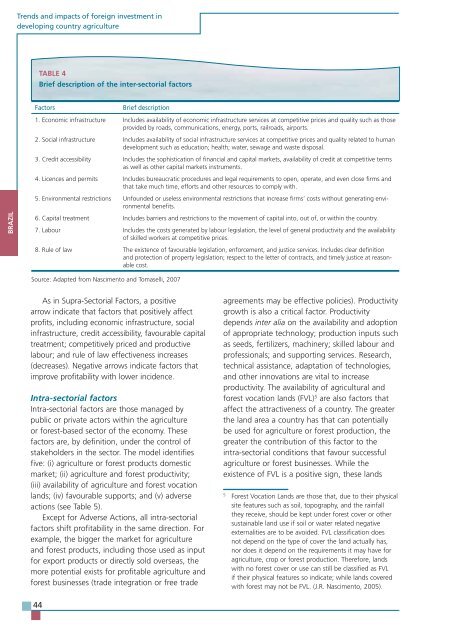TRENDS AND IMPACTS OF FOREIGN INVESTMENT IN DEVELOPING COUNTRY AGRICULTURE
TRENDS AND IMPACTS OF FOREIGN INVESTMENT IN DEVELOPING COUNTRY AGRICULTURE
TRENDS AND IMPACTS OF FOREIGN INVESTMENT IN DEVELOPING COUNTRY AGRICULTURE
Create successful ePaper yourself
Turn your PDF publications into a flip-book with our unique Google optimized e-Paper software.
BRAZIL<br />
Trends and impacts of foreign investment in<br />
developing country agriculture<br />
TABLE 4<br />
Brief description of the inter-sectorial factors<br />
Factors Brief description<br />
1. Economic infrastructure Includes availability of economic infrastructure services at competitive prices and quality such as those<br />
provided by roads, communications, energy, ports, railroads, airports.<br />
2. Social infrastructure Includes availability of social infrastructure services at competitive prices and quality related to human<br />
development such as education; health; water, sewage and waste disposal.<br />
3. Credit accessibility Includes the sophistication of financial and capital markets, availability of credit at competitive terms<br />
as well as other capital markets instruments.<br />
4. Licences and permits Includes bureaucratic procedures and legal requirements to open, operate, and even close firms and<br />
that take much time, efforts and other resources to comply with.<br />
5. Environmental restrictions Unfounded or useless environmental restrictions that increase firms’ costs without generating environmental<br />
benefits.<br />
6. Capital treatment Includes barriers and restrictions to the movement of capital into, out of, or within the country.<br />
7. Labour Includes the costs generated by labour legislation, the level of general productivity and the availability<br />
of skilled workers at competitive prices.<br />
8. Rule of law The existence of favourable legislation, enforcement, and justice services. Includes clear definition<br />
and protection of property legislation; respect to the letter of contracts, and timely justice at reasonable<br />
cost.<br />
Source: Adapted from Nascimento and Tomaselli, 2007<br />
As in Supra-Sectorial Factors, a positive<br />
arrow indicate that factors that positively affect<br />
profits, including economic infrastructure, social<br />
infrastructure, credit accessibility, favourable capital<br />
treatment; competitively priced and productive<br />
labour; and rule of law effectiveness increases<br />
(decreases). Negative arrows indicate factors that<br />
improve profitability with lower incidence.<br />
Intra-sectorial factors<br />
Intra-sectorial factors are those managed by<br />
public or private actors within the agriculture<br />
or forest-based sector of the economy. These<br />
factors are, by definition, under the control of<br />
stakeholders in the sector. The model identifies<br />
five: (i) agriculture or forest products domestic<br />
market; (ii) agriculture and forest productivity;<br />
(iii) availability of agriculture and forest vocation<br />
lands; (iv) favourable supports; and (v) adverse<br />
actions (see Table 5).<br />
Except for Adverse Actions, all intra-sectorial<br />
factors shift profitability in the same direction. For<br />
example, the bigger the market for agriculture<br />
and forest products, including those used as input<br />
for export products or directly sold overseas, the<br />
more potential exists for profitable agriculture and<br />
forest businesses (trade integration or free trade<br />
44<br />
agreements may be effective policies). Productivity<br />
growth is also a critical factor. Productivity<br />
depends inter alia on the availability and adoption<br />
of appropriate technology; production inputs such<br />
as seeds, fertilizers, machinery; skilled labour and<br />
professionals; and supporting services. Research,<br />
technical assistance, adaptation of technologies,<br />
and other innovations are vital to increase<br />
productivity. The availability of agricultural and<br />
forest vocation lands (FVL) 5 are also factors that<br />
affect the attractiveness of a country. The greater<br />
the land area a country has that can potentially<br />
be used for agriculture or forest production, the<br />
greater the contribution of this factor to the<br />
intra-sectorial conditions that favour successful<br />
agriculture or forest businesses. While the<br />
existence of FVL is a positive sign, these lands<br />
5 Forest Vocation Lands are those that, due to their physical<br />
site features such as soil, topography, and the rainfall<br />
they receive, should be kept under forest cover or other<br />
sustainable land use if soil or water related negative<br />
externalities are to be avoided. FVL classification does<br />
not depend on the type of cover the land actually has,<br />
nor does it depend on the requirements it may have for<br />
agriculture, crop or forest production. Therefore, lands<br />
with no forest cover or use can still be classified as FVL<br />
if their physical features so indicate; while lands covered<br />
with forest may not be FVL. (J.R. Nascimento, 2005).


